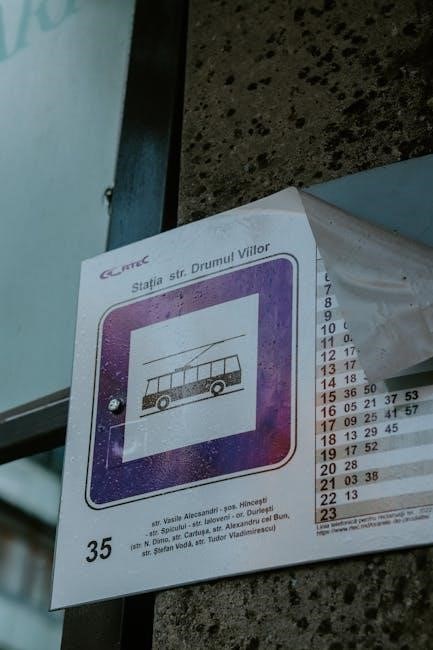The Hyundai Santa Fe service schedule is a comprehensive guide ensuring optimal vehicle performance and longevity. Regular maintenance, as outlined in the PDF, includes oil changes, tire rotations, and brake inspections, all designed to prevent issues and keep your SUV running smoothly. Adhering to the schedule helps maintain warranty compliance and prevents costly repairs, ensuring your Santa Fe operates at its best for years to come;
1.1 Importance of Regular Maintenance for Hyundai Santa Fe
Regular maintenance is crucial for the Hyundai Santa Fe to ensure reliability, performance, and longevity. Neglecting scheduled services can lead to decreased fuel efficiency, reduced safety, and costly repairs. By following the recommended intervals, owners can prevent premature wear on critical components like the engine, brakes, and tires. Proper upkeep also maintains warranty compliance, ensuring coverage for unexpected issues. Additionally, regular inspections help identify potential problems early, avoiding breakdowns and enhancing overall driving safety. Investing in routine maintenance is essential for preserving the vehicle’s value and ensuring it runs smoothly for years to come.
1.2 Overview of the Service Schedule PDF
The Hyundai Santa Fe Service Schedule PDF is a detailed guide outlining the recommended maintenance intervals and procedures for optimal vehicle performance. It provides a clear timeline for essential services, such as oil changes, tire rotations, and brake inspections, ensuring owners can plan accordingly. The PDF also specifies the use of Hyundai Genuine Parts and recommends authorized dealers for warranty compliance. By following the schedule, owners can address potential issues early, reducing the risk of costly repairs. The document is designed to be user-friendly, offering a structured approach to maintaining the Santa Fe’s longevity and reliability, ensuring it performs at its best for years to come.

Recommended Maintenance Intervals
Hyundai Santa Fe maintenance is recommended every 7,500 miles or 6 months, including oil and filter changes, tire rotations, and multi-point inspections for optimal performance and longevity.
2.1 Oil and Filter Change Intervals
The Hyundai Santa Fe service schedule recommends oil and filter changes every 7,500 miles or 6 months to ensure engine longevity and optimal performance. Using the correct viscosity oil is crucial, as specified in the PDF guide, to maintain proper lubrication and prevent premature wear. Regular oil changes help remove contaminants and reduce friction, which can extend the life of your engine. Additionally, the oil filter should be replaced at the same time to ensure clean oil circulation. Following this interval is essential for maintaining fuel efficiency, reducing emissions, and preventing costly engine repairs down the line. Always refer to your owner’s manual or the service schedule PDF for specific recommendations tailored to your vehicle’s conditions.
2.2 Tire Rotation Schedule
The Hyundai Santa Fe service schedule recommends tire rotations every 7,500 miles or 6 months to ensure even tread wear and optimal performance. Regular rotations help distribute wear evenly across all tires, improving traction, handling, and fuel efficiency. The PDF guide provides a specific pattern for rotating tires, which varies depending on the vehicle’s drivetrain and tire type. Proper rotation also helps maintain balanced vehicle stability and prevents uneven wear that could lead to premature tire replacement. Always refer to the service schedule or owner’s manual for detailed instructions tailored to your Santa Fe’s configuration and driving conditions.
2.3 Brake Inspection and Maintenance
The Hyundai Santa Fe service schedule recommends brake inspections every 12,000 miles or at the first sign of wear. Regular checks ensure safety by identifying worn pads, rotors, or fluid issues. The PDF guide outlines specific inspection points, including brake pad thickness, rotor condition, and fluid levels. Early detection of wear prevents costly repairs and maintains reliable stopping performance. Hyundai advises using genuine parts for replacements to ensure optimal braking efficiency. Neglecting brake maintenance can lead to reduced safety and increased repair costs. Always follow the recommended intervals and consult the service schedule for detailed guidelines tailored to your vehicle’s needs.
2.4 Fluid Check and Replacement
Regular fluid checks are essential for the Hyundai Santa Fe’s performance and longevity. The service schedule PDF recommends inspecting engine oil, coolant, transmission, and brake fluid levels during routine maintenance. Coolant should be replaced every 30,000 to 60,000 miles to prevent corrosion and overheating. Transmission fluid replacement is typically required every 60,000 miles to maintain smooth gear operation. Brake fluid should be checked annually and replaced as needed to ensure reliable braking systems. Neglecting fluid maintenance can lead to engine damage or system failure. Always use Hyundai-approved fluids to meet specific viscosity and formulation requirements. Refer to the PDF for detailed intervals and guidelines tailored to your vehicle’s needs.

Key Services Included in the Schedule
The Hyundai Santa Fe service schedule includes essential checks like oil and filter changes, tire rotations, and multi-point inspections. It also covers battery health, air filter, and spark plug replacements to ensure optimal performance and longevity.
3.1 Multi-Point Inspection
A multi-point inspection is a thorough check of your Hyundai Santa Fe’s critical systems. This service evaluates the condition of brakes, belts, hoses, and suspension components. Technicians also inspect the battery, air filter, and fluid levels to ensure everything is within manufacturer specifications. The inspection helps identify potential issues early, preventing unexpected breakdowns and costly repairs. It’s typically performed during routine maintenance visits, such as oil changes, to provide a comprehensive overview of your vehicle’s health. This proactive approach ensures your Santa Fe remains reliable and safe on the road.
3.2 Battery Health Check
A battery health check is a crucial part of the Hyundai Santa Fe service schedule. This inspection ensures your vehicle’s battery is functioning properly and identifies potential issues before they cause breakdowns. Technicians test the battery’s charge level, check terminals for corrosion, and assess the overall condition. A healthy battery is essential for reliable starting and operation of electrical systems. Regular checks can prevent sudden failures, especially in extreme temperatures. This service is typically included in routine maintenance visits to ensure your Santa Fe starts effortlessly and runs smoothly year-round.
3.3 Air Filter Replacement
Air filter replacement is a key service included in the Hyundai Santa Fe maintenance schedule, typically recommended every 15,000 to 30,000 miles. A clean air filter ensures optimal engine performance, fuel efficiency, and reduces emissions. Dusty or clogged filters can decrease performance and gas mileage. Technicians inspect and replace the cabin and engine air filters during routine services. Regular replacements help maintain a healthy engine and improve overall vehicle efficiency. This simple yet important service is detailed in the PDF guide, ensuring your Santa Fe runs smoothly and efficiently under various driving conditions.
3.4 Spark Plug Replacement
Spark plug replacement is a crucial service in the Hyundai Santa Fe maintenance schedule, typically recommended between 30,000 to 105,000 miles, depending on driving conditions. Worn-out spark plugs can lead to misfires, reducing engine performance and fuel efficiency. During this service, technicians inspect and replace spark plugs to ensure proper engine combustion; This maintenance is essential for maintaining smooth engine operation, preventing costly repairs, and optimizing overall vehicle performance. The PDF guide outlines the specific intervals and procedures for spark plug replacement, ensuring your Santa Fe continues to deliver reliable power and efficiency on the road.

Understanding the Service Schedule PDF
The Hyundai Santa Fe Service Schedule PDF is a detailed guide outlining maintenance intervals, procedures, and recommendations. It ensures clarity and ease in planning regular servicing, helping owners keep their vehicle in optimal condition while adhering to manufacturer standards.
4.1 How to Access the PDF Guide
Accessing the Hyundai Santa Fe Service Schedule PDF is straightforward. Visit the official Hyundai website or authorized dealerships for downloadable guides specific to your model year. Additionally, online platforms offer free PDF downloads of repair manuals and maintenance schedules. Ensure authenticity by verifying sources, as accurate information is crucial for proper vehicle care. This guide is essential for understanding maintenance intervals, ensuring your Santa Fe operates efficiently and maintains its warranty compliance. Regular updates are available, so check periodically for the latest version tailored to your vehicle’s needs.

4.2 Navigating the Schedule
Navigating the Hyundai Santa Fe Service Schedule PDF is designed to be user-friendly. The document is organized by mileage and time intervals, with clear sections for different maintenance tasks. Each service milestone includes detailed instructions and recommendations, ensuring you know exactly what is needed at specific points. The PDF also includes tire pressure charts, fuse assignments, and scheduled maintenance tables for quick reference. By following the index or table of contents, you can easily locate the information you need. This organized structure helps ensure no maintenance steps are overlooked, keeping your vehicle in optimal condition and prolonging its lifespan effectively.
4.3 Interpreting Service Milestones
Service milestones in the Hyundai Santa Fe Service Schedule PDF are structured by mileage or time intervals, outlining specific maintenance tasks. Each milestone provides clear recommendations, such as oil changes every 7,500 miles, tire rotations, and brake inspections. Coolant replacement is suggested every 80,000 km, using pre-mix coolant for optimal performance. These milestones ensure essential tasks are addressed progressively, preventing potential issues. By following these guidelines, you can interpret the necessary services at each interval, ensuring your vehicle remains in peak condition and avoiding unexpected repairs. This structured approach helps maintain reliability and extends the lifespan of your Hyundai Santa Fe effectively over time.

Importance of Adhering to the Schedule
Adhering to the Hyundai Santa Fe service schedule ensures optimal performance, prevents costly repairs, and extends the vehicle’s lifespan. Regular maintenance maintains warranty compliance and safeguards reliability.
5.1 Preventing Unnecessary Repairs
Regular maintenance as per the Hyundai Santa Fe service schedule prevents unnecessary repairs by identifying potential issues early. Oil changes prevent engine wear, tire rotations ensure even tread wear, and brake inspections catch problems before they escalate. Addressing these areas early avoids costly fixes down the line, ensuring your vehicle runs smoothly and efficiently. By following the recommended intervals, you can prevent unexpected breakdowns and maintain your SUV’s performance. This proactive approach saves money and extends the life of your Santa Fe, keeping it in optimal condition for years to come.
5.2 Extending Vehicle Lifespan
Following the Hyundai Santa Fe service schedule is crucial for extending the lifespan of your vehicle. Regular oil changes prevent engine wear, while tire rotations ensure even tread wear, prolonging tire life. Brake inspections and fluid checks help maintain critical systems, preventing premature deterioration. By addressing these areas, you protect your SUV from excessive wear and tear, ensuring it remains reliable for years. The structured maintenance plan in the PDF guide is designed to maximize longevity, keeping your Santa Fe in prime condition and maintaining its performance and reliability over time.
5.3 Maintaining Warranty Compliance
Maintaining warranty compliance is essential for Hyundai Santa Fe owners, as failure to follow the recommended service schedule can void the manufacturer’s warranty. Hyundai’s warranty requires adherence to the outlined maintenance intervals and procedures, ensuring all services are performed by authorized dealers using genuine parts. The service schedule PDF provides clear guidelines to help owners stay compliant, avoiding potential issues during warranty claims. Regular maintenance not only protects your vehicle but also ensures warranty coverage remains valid, safeguarding your investment and providing peace of mind. Keeping detailed records of all services is crucial for verifying compliance when needed.

DIY Maintenance vs. Dealership Service
DIY maintenance offers cost savings and flexibility but requires mechanical skills and genuine parts. Dealership service provides expertise, warranty compliance, and access to specialized tools, ensuring reliability and peace of mind.
6.1 Pros and Cons of DIY Maintenance
DIY maintenance offers cost savings, flexibility, and personal satisfaction but requires mechanical expertise. Pros include reduced labor costs and convenience, while cons involve potential errors without proper knowledge. Specialized tools may be needed, and improper repairs can lead to further issues. Warranty compliance might be at risk if procedures aren’t followed correctly. Balancing these factors is crucial for effective DIY maintenance on your Hyundai Santa Fe.
6.2 Benefits of Using Authorized Dealers
Using authorized Hyundai dealers ensures expert service by trained technicians familiar with your Santa Fe’s specifications. They utilize genuine Hyundai parts, designed for optimal performance and reliability. Dealerships offer convenient scheduling, advanced diagnostic tools, and a clean, professional environment. Additionally, services performed by authorized dealers maintain warranty compliance, protecting your investment. They also provide access to the latest software updates and recall notifications, ensuring your vehicle is up-to-date. The peace of mind from knowing the job is done correctly, combined with the quality of genuine parts, makes authorized dealers a top choice for maintaining your Hyundai Santa Fe.

Troubleshooting Common Service Issues
Common issues like oil consumption and brake concerns can be identified through warning signs. Refer to the PDF for diagnostic guidance and solutions to address these problems effectively.
7.1 Identifying Warning Signs
Identifying warning signs early is crucial for maintaining your Hyundai Santa Fe. Look for unusual noises, decreased performance, or dashboard warning lights. Oil consumption issues, brake system concerns, and fluid leaks are common indicators requiring attention. Consult the service schedule PDF for guidance on recognizing these signs. Regular inspections can help detect problems before they escalate, ensuring timely repairs and preventing major damage. Addressing these issues promptly is key to maintaining your vehicle’s reliability and longevity. Always refer to the PDF for specific guidance on troubleshooting and scheduling necessary maintenance.
7.2 Addressing Oil Consumption Issues
Oil consumption issues in the Hyundai Santa Fe can be managed by monitoring oil levels regularly and adhering to the service schedule. If your vehicle shows signs of excessive oil use, check for leaks and ensure proper PCV system function. Refer to the PDF guide for recommendations on oil type and change intervals. If issues persist, consult a Hyundai specialist to inspect internal engine components. Regular maintenance, such as timely oil changes, can help mitigate oil consumption problems. Always follow the guidelines outlined in the service schedule to address this concern effectively and prevent potential engine damage.
7.3 Resolving Brake System Concerns
Addressing brake system concerns in your Hyundai Santa Fe involves regular inspections and timely repairs. Check brake pads and rotors during scheduled maintenance to ensure proper function. If you notice unusual noises or reduced braking performance, consult the service schedule PDF for guidance. Replace worn brake components promptly to avoid safety risks. Use Hyundai Genuine Parts for reliability. If issues persist, have a certified technician inspect the brake system. Regular maintenance, such as brake fluid checks, can prevent major repairs. Follow the recommended intervals to keep your braking system in optimal condition and ensure your vehicle remains safe to drive.
Additional Resources
Explore Hyundai workshop manuals, official website support, and community forums for detailed guides, DIY tips, and expert advice on maintaining your Santa Fe.
- Hyundai workshop repair manuals.
- Official Hyundai website and support.
- Community forums and DIY guides.
8.1 Hyundai Workshop Repair Manuals
Hyundai workshop repair manuals provide detailed instructions and specifications for servicing and repairing your Santa Fe. These manuals, used by authorized dealers, cover diagnostics, repairs, and maintenance procedures. They include wiring diagrams, parts lists, and troubleshooting guides, ensuring accurate repairs. Available as PDF downloads, they cover various models, including the Santa Fe, offering step-by-step guidance for DIY enthusiasts and professionals alike. Access these manuals through Hyundai’s official website or authorized dealers to ensure your vehicle is serviced correctly and efficiently.
- Detailed repair and maintenance instructions.
- Wiring diagrams and specifications.
- Coverage for various Hyundai models.
- Available as downloadable PDFs.
8.2 Official Hyundai Website and Support
The official Hyundai website offers extensive resources for Santa Fe owners, including service schedules, repair manuals, and maintenance tips. Visitors can explore vehicle lineups, brand initiatives, and personalize their cars with genuine accessories. The site provides tools to find local dealers, book services, and access Hyundai Genuine Parts. Additionally, Hyundai’s support section includes FAQs, troubleshooting guides, and contact information for customer service. Whether you’re scheduling maintenance or seeking advice, the official website is a reliable source for all your Santa Fe needs, ensuring a seamless ownership experience with up-to-date information and expert assistance.

8.3 Community Forums and DIY Guides
Community forums and DIY guides offer valuable insights and practical advice for maintaining your Hyundai Santa Fe. Enthusiast forums provide real-life experiences, tips, and troubleshooting solutions from fellow owners. DIY guides, often shared online, detail step-by-step procedures for common maintenance tasks, such as oil changes and tire rotations. These resources empower owners to take control of their vehicle’s upkeep, saving costs and fostering a sense of community. While these guides are helpful, always verify information with official Hyundai resources to ensure accuracy and safety. They complement the service schedule PDF, offering a collaborative approach to vehicle care and customization.
Following the Hyundai Santa Fe service schedule ensures optimal performance, prevents repairs, and extends lifespan. Regular maintenance, guided by the PDF, supports your vehicle’s health and reliability long-term.

9.1 Summary of Key Takeaways
9.2 Final Thoughts on Maintenance Importance
Regular maintenance is the cornerstone of preserving your Hyundai Santa Fe’s performance and longevity. By following the service schedule, you ensure reliability, safety, and optimal functionality. Neglecting routine care can lead to costly repairs and reduced vehicle lifespan. Consistent upkeep not only safeguards your investment but also enhances driving comfort and efficiency. Remember, preventive maintenance is key to avoiding unforeseen issues. Stay proactive with your Santa Fe’s care to enjoy years of trouble-free driving and maintain its value. Proper maintenance is an investment in both your vehicle and your peace of mind.
